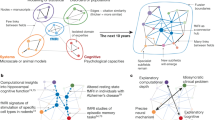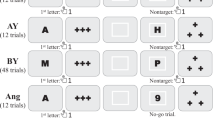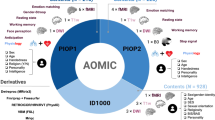Abstract
For centuries people have aspired to understand and control the functions of the mind and brain. It has now become possible to image the functioning of the human brain in real time using functional MRI (fMRI), and thereby to access both sides of the mind–brain interface — subjective experience (that is, one's mind) and objective observations (that is, external, quantitative measurements of one's brain activity) — simultaneously. Developments in neuroimaging are now being translated into many new potential practical applications, including the reading of brain states, brain–computer interfaces, communicating with locked-in patients, lie detection, and learning control over brain activation to modulate cognition or even treat disease.
This is a preview of subscription content, access via your institution
Access options
Subscribe to this journal
Receive 12 print issues and online access
$189.00 per year
only $15.75 per issue
Buy this article
- Purchase on Springer Link
- Instant access to full article PDF
Prices may be subject to local taxes which are calculated during checkout





Similar content being viewed by others
References
Descartes, R., Haldane, E. S. & Ross, G. R. T. The Philosophical Works of Descartes Vol. 2 (Cambridge Univ. Press, 1981).
Cabeza, R. & Kingstone, A. Handbook of Functional Neuroimaging of Cognition Vol. 3 (MIT Press, Cambridge, Massachusetts, 2001).
Gazzaniga, M. S. The Cognitive Neurosciences 3rd edn (MIT Press, Cambridge, Massachusetts, 2004).
Cox, R. W., Jesmanowicz, A. & Hyde, J. S. Real-time functional magnetic resonance imaging. Magn. Reson. Med. 33, 230–236 (1995).
Cohen, M. S. Real-time functional magnetic resonance imaging. Methods 25, 201–220 (2001).
deCharms, R. C. Reading and controlling human brain activation using real-time functional magnetic resonance imaging. Trends Cogn. Sci. 11, 473–481 (2007).
Weiskopf, N. et al. Real-time functional magnetic resonance imaging: methods and applications. Magn. Reson. Imaging 25, 989–1003 (2007).
Weiskopf, N. et al. Self-regulation of local brain activity using real-time functional magnetic resonance imaging (fMRI). J. Physiol. (Paris) 98, 357–373 (2004).
Weiskopf, N. et al. Principles of a brain-computer interface (BCI) based on real-time functional magnetic resonance imaging (fMRI). IEEE Trans. Biomed. Eng. 51, 966–970 (2004).
Buxton, R. B. Introduction to Functional Magnetic Resonance Imaging: Principles and Techniques (Cambridge Univ. Press, Cambridge, UK, 2002).
Bandettini, P. A., Aguirre, G. K. & Moonen, C. T. W. Functional MRI. Medical Radiology (Springer, Berlin; New York, 1999).
Bernstein, M. A., King, K. F. & Zhou, Z. J. Handbook of MRI Pulse Sequences (Academic, Amsterdam; Boston, 2004).
Lopes da Silva, F. Functional localization of brain sources using EEG and/or MEG data: volume conductor and source models. Magn. Reson. Imaging 22, 1533–1538 (2004).
Irani, F. et al. Functional near infrared spectroscopy (fNIRS): an emerging neuroimaging technology with important applications for the study of brain disorders. Clin. Neuropsychol. 21, 9–37 (2007).
deCharms, R. C. & Zador, A. Neural representation and the cortical code. Annu. Rev. Neurosci. 23, 613–647 (2000).
Zarahn, E. Spatial localization and resolution of BOLD fMRI. Curr. Opin. Neurobiol. 11, 209–212 (2001).
deCharms, R. C. & Merzenich, M. M. Primary cortical representation of sounds by the coordination of action-potential timing. Nature 381, 610–613 (1996).
Averbeck, B. B. & Lee, D. Coding and transmission of information by neural ensembles. Trends Neurosci. 27, 225–230 (2004).
Gawne, T. J. Temporal coding as a means of information transfer in the primate visual system. Crit. Rev. Neurobiol. 13, 83–101 (1999).
Reich, D. S. et al. Interspike intervals, receptive fields, and information encoding in primary visual cortex. J. Neurosci. 20, 1964–1974 (2000).
Lebedev, M. A. & Nicolelis, M. A. Brain-machine interfaces: past, present and future. Trends Neurosci. 29, 536–546 (2006).
Mason, S. G. et al. A comprehensive survey of brain interface technology designs. Ann. Biomed. Eng. 35, 137–169 (2007).
Birbaumer, N. Breaking the silence: brain-computer interfaces (BCI) for communication and motor control. Psychophysiology 43, 517–532 (2006).
Birbaumer, N. & Cohen, L. G. Brain-computer interfaces: communication and restoration of movement in paralysis. J. Physiol. 579, 621–636 (2007).
Duda, R. O., Hart, P. E. & Stork, D. G. Pattern Classification 2nd edn (Wiley, New York, 2001).
Cox, D. D. & Savoy, R. L. Functional magnetic resonance imaging (fMRI) “brain reading”: detecting and classifying distributed patterns of fMRI activity in human visual cortex. Neuroimage 19, 261–270 (2003).
Haxby, J. V. et al. Distributed and overlapping representations of faces and objects in ventral temporal cortex. Science 293, 2425–2430 (2001).
Norman, K. A. et al. Beyond mind-reading: multi-voxel pattern analysis of fMRI data. Trends Cogn. Sci. 10, 424–430 (2006).
Carlson, T. A., Schrater, P. & He, S. Patterns of activity in the categorical representations of objects. J. Cogn. Neurosci. 15, 704–717 (2003).
Davatzikos, C. et al. Classifying spatial patterns of brain activity with machine learning methods: application to lie detection. Neuroimage 28, 663–668 (2005).
Hanson, S. J., Matsuka, T. & Haxby, J. V. Combinatorial codes in ventral temporal lobe for object recognition: Haxby (2001) revisited: is there a “face” area? Neuroimage 23, 156–166 (2004).
Martinez-Ramon, M. et al. fMRI pattern classification using neuroanatomically constrained boosting. Neuroimage 31, 1129–1141 (2006).
O'Toole, A. J. et al. Partially distributed representations of objects and faces in ventral temporal cortex. J. Cogn. Neurosci. 17, 580–590 (2005).
Dehaene, S. et al. Inferring behavior from functional brain images. Nature Neurosci. 1, 549–550 (1998).
LaConte, S. et al. The evaluation of preprocessing choices in single-subject BOLD fMRI using NPAIRS performance metrics. Neuroimage 18, 10–27 (2003).
Mitchell, T. M. Machine Learning. McGraw-Hill Series in Computer Science (McGraw-Hill, New York, 1997).
Kay, K. N. et al. Identifying natural images from human brain activity. Nature, 452, 352–355 (2008).
Posse, S. et al. A new approach to measure single-event related brain activity using real-time fMRI: feasibility of sensory, motor, and higher cognitive tasks. Hum. Brain Mapp. 12, 25–41 (2001).
Haynes, J. D. & Rees, G. Decoding mental states from brain activity in humans. Nature Rev. Neurosci. 7, 523–534 (2006).
Haynes, J. D. & Rees, G. Predicting the stream of consciousness from activity in human visual cortex. Curr. Biol. 15, 1301–1307 (2005).
Kamitani, Y. & Tong, F. Decoding the visual and subjective contents of the human brain. Nature Neurosci. 8, 679–685 (2005).
Thirion, B. et al. Inverse retinotopy: inferring the visual content of images from brain activation patterns. Neuroimage 33, 1104–1116 (2006).
Polyn, S. M. et al. Category-specific cortical activity precedes retrieval during memory search. Science, 310, 1963–1966 (2005).
LaConte, S. et al. Support vector machines for temporal classification of block design fMRI data. Neuroimage, 26, 317–329 (2005).
Laconte, S. M., Peltier, S. J. & Hu, X. P. Real-time fMRI using brain-state classification. Hum. Brain Mapp. 28, 1033–1044 (2006).
Owen, A. M. et al. Detecting awareness in the vegetative state. Science 313, 1402 (2006).
Nachev, P. & Husain, M. Comment on “Detecting awareness in the vegetative state”. Science 315, 1221; author reply 1221 (2007).
Greenberg, D. L. Comment on “Detecting awareness in the vegetative state”. Science, 315, 1221; author reply 1221 (2007).
Coleman, M. R. et al. Do vegetative patients retain aspects of language comprehension? Evidence from fMRI. Brain 130, 2494–2507 (2007).
Owen, A. M. et al. Using functional magnetic resonance imaging to detect covert awareness in the vegetative state. Arch. Neurol. 64, 1098–1102 (2007).
Di, H. B. et al. Cerebral response to patient's own name in the vegetative and minimally conscious states. Neurology 68, 895–899 (2007).
Bernat, J. L. & Rottenberg, D. A. Conscious awareness in PVS and MCS: the borderlands of neurology. Neurology 68, 885–886 (2007).
Owen, A. M. & Coleman, M. R. Functional neuroimaging of the vegetative state. Nature Rev. Neurosci. 9, 235–243 (2008).
Spence, S. A. et al. A cognitive neurobiological account of deception: evidence from functional neuroimaging. Philos. Trans. R. Soc. Lond. B Biol. Sci. 359, 1755–1762 (2004).
Langleben, D. D. et al. Telling truth from lie in individual subjects with fast event-related fMRI. Hum. Brain Mapp. 26, 262–272 (2005).
Spence, S. A. et al. Behavioural and functional anatomical correlates of deception in humans. Neuroreport 12, 2849–2853 (2001).
Langleben, D. D. et al. Brain activity during simulated deception: an event-related functional magnetic resonance study. Neuroimage 15, 727–732 (2002).
Ganis, G. et al. Neural correlates of different types of deception: an fMRI investigation. Cereb. Cortex 13, 830–836 (2003).
Kozel, F. A. et al. Detecting deception using functional magnetic resonance imaging. Biol. Psychiatry 58, 605–613 (2005).
Nunez, J. M. et al. Intentional false responding shares neural substrates with response conflict and cognitive control. Neuroimage 25, 267–277 (2005).
Thompson, S. K. The legality of the use of psychiatric neuroimaging in intelligence interrogation. Cornell Law Rev. 90, 1601–1637 (2005).
Appelbaum, P. S. Law & psychiatry: the new lie detectors: neuroscience, deception, and the courts. Psychiatr. Serv. 58, 460–462 (2007).
Wild, J. Brain imaging ready to detect terrorists, say neuroscientists. Nature 437, 457 (2005).
Meegan, D. V. Neuroimaging techniques for memory detection: scientific, ethical, and legal issues. Am. J. Bioeth. 8, 9–20 (2008).
Yoo, S. S. et al. Brain-computer interface using fMRI: spatial navigation by thoughts. Neuroreport 15, 1591–1595 (2004).
Peplow, M. Mental ping-pong could aid paraplegics. Nature News 23 Aug 2004 (doi: 10.1038/news040823-18).
Fetz, E. E. & Finocchio, D. V. Operant conditioning of specific patterns of neural and muscular activity. Science 174, 431–435 (1971).
Nowlis, D. P. & Kamiya, J. The control of electroencephalographic alpha rhythms through auditory feedback and the associated mental activity. Psychophysiology 6, 476–484 (1970).
Manuck, S. B. et al. Role of feedback in voluntary control of heart rate. Percept. Mot. Skills 40, 747–752 (1975).
Allen, J. J., Harmon-Jones, E. & Cavender, J. H. Manipulation of frontal EEG asymmetry through biofeedback alters self-reported emotional responses and facial EMG. Psychophysiology 38, 685–693 (2001).
Elbert, T. Self-Regulation of the Brain and Behavior (Springer, Berlin; New York, 1984).
Friel, P. N. EEG biofeedback in the treatment of attention deficit hyperactivity disorder. Altern. Med. Rev. 12, 146–151 (2007).
Lubar, J. F. & Deering, W. M. Behavioral Approaches to Neurology. Behavioral Medicine Series (Academic, New York, 1981).
deCharms, R. C. et al. Learned regulation of spatially localized brain activation using real-time fMRI. Neuroimage 21, 436–443 (2004).
Weiskopf, N. et al. Physiological self-regulation of regional brain activity using real-time functional magnetic resonance imaging (fMRI): methodology and exemplary data. Neuroimage 19, 577–586 (2003).
Yoo, S. S. & Jolesz, F. A. Functional MRI for neurofeedback: feasibility study on a hand motor task. Neuroreport 13, 1377–1381 (2002).
Posse, S. et al. Real-time fMRI of temporolimbic regions detects amygdala activation during single-trial self-induced sadness. Neuroimage 18, 760–768 (2003).
Yoo, S. S. et al. Increasing cortical activity in auditory areas through neurofeedback functional magnetic resonance imaging. Neuroreport 17, 1273–1278 (2006).
Caria, A. et al. Regulation of anterior insular cortex activity using real-time fMRI. Neuroimage 35, 1238–1246 (2007).
deCharms, R. C. et al. Control over brain activation and pain learned by using real-time functional MRI. Proc. Natl Acad. Sci. USA 102, 18626–18631 (2005).
Fetz, E. E. Volitional control of neural activity: implications for brain-computer interfaces. J. Physiol. 579, 571–579 (2007).
Rainville, P. Brain mechanisms of pain affect and pain modulation. Curr. Opin. Neurobiol. 12, 195–204 (2002).
Apkarian, A. V. Functional magnetic resonance imaging of pain consciousness: cortical networks of pain critically depend on what is implied by “pain”. Curr. Rev. Pain 3, 308–315 (1999).
Moisset, X. & Bouhassira, D. Brain imaging of neuropathic pain. Neuroimage 37 (Suppl. 1), S80–S88 (2007).
Petrovic, P. & Ingvar, M. Imaging cognitive modulation of pain processing. Pain 95, 1–5 (2002).
Peyron, R., Laurent, B. & Garcia-Larrea, L. Functional imaging of brain responses to pain. A review and meta-analysis. Neurophysiol. Clin. 30, 263–288 (2000).
Rainville, P. Brain mechanisms of pain affect and pain modulation. Curr. Opin. Neurobiol. 12, 195–204 (2002).
Tracey, I. Imaging pain. Br. J. Anaesth. 101, 32–39 (2008).
Bray, S., Shimojo, S. & O'Doherty, J. P. Direct instrumental conditioning of neural activity using functional magnetic resonance imaging-derived reward feedback. J. Neurosci. 27, 7498–7507 (2007).
Buonomano, D. V. & Merzenich, M. M. Cortical plasticity: from synapses to maps. Annu. Rev. Neurosci. 21, 149–186 (1998).
Merzenich, M. M. & deCharms, R. C. in The Mind-Brain Continuum (eds Llinas, R. & Churchland, P.) (MIT Press, Boston, 1996).
Moore, N. C. A review of EEG biofeedback treatment of anxiety disorders. Clin. Electroencephalogr. 31, 1–6 (2000).
Sterman, M. B. & Egner, T. Foundation and practice of neurofeedback for the treatment of epilepsy. Appl. Psychophysiol. Biofeedback 31, 21–35 (2006).
Gruzelier, J. & Egner, T. Critical validation studies of neurofeedback. Child Adolesc. Psychiatr. Clin. N. Am. 14, 83–104, vi (2005).
Phan, K. L. et al. Real-time fMRI of cortico-limbic brain activity during emotional processing. Neuroreport 15, 527–532 (2004).
Adcock, R. A. et al. Real time fMRI during the psychotherapy session: toward a methodology to augment therapeutic benefit. 11th Ann. Meeting Organ. Hum. Brain Mapp. (Toronto, Ontario, Canada, 2005).
Acknowledgements
This work was funded by US National Institutes of Health Grants and Contracts MH067290, NS050642, NS049673, N43DA-4-7748, DA021877, and N43DA-7-4408.
Author information
Authors and Affiliations
Ethics declarations
Competing interests
This work was funded by US National Institutes of Health Grants and Contracts MH067290, NS050642, NS049673, N43DA-4-7748, DA021877 and N43DA-7-4408 to Omneuron Inc., a venture that is developing clinical applications of real-time functional MRI and that is conducting ongoing clinical trials of this approach. R. Christopher deCharms is CEO of this venture and has an ownership interest.
Related links
Glossary
- Biofeedback
-
A technique in which a continuous measure of some aspect of a person's biology is presented to that person for the purpose of training them to control the measure and, thereby, the corresponding biological function.
- Contrast agent
-
A chemical agent that, when injected into a person, increases the measured contrast (the difference in image intensity) between different types of tissue. For example, a Gadolinium-based dye is sometimes used in MRI.
- EEG
-
(Electroencephalography). A method for measuring the fast electrical activity in the brain that is associated with neuronal activation.
- Locked-in syndrome
-
A medical state in which a patient has very limited or no ability to communicate with the world, often owing to extensive paralysis.
- MEG
-
(Magnetoencephalography). A method for measuring the fast magnetic activity in the brain that is associated with neuronal activation.
- Near-infrared spectroscopy
-
A method used for measuring brain blood flow and oxygenation near the cranial surface by shining near-infrared light through the skull and measuring the resulting emitted light spectrum, which is indicative of blood properties.
- Pattern-classification algorithm
-
A computer-modelling method for classifying statistical patterns in complex multi-parameter data. For example, pattern-classification algorithms have been built that will classify spatial patterns of fMRI data (2D images or 3D volumes) by estimating what task a subject was undertaking when each particular fMRI pattern was measured.
- Persistent vegetative state
-
A medical condition in which a patient shows sustained unresponsiveness and does not show evidence of awareness.
- Region of interest (ROI) analysis
-
A method for measuring the time course of activation from a selected volume of the brain. This method can be used to infer the average activation in a region of a person's brain that has been caused by a stimulus or task, or conversely a level of ROI activation can be used to attempt to infer what task is being undertaken by a person.
- Spatial-point spread function
-
The amount of spread, through space, of the measured signal that arises from an idealized single point in space. Spatial spread is caused by noise and imperfections in the measurement technique, for instance MRI.
- Voxel
-
A 3D volume element of measurement (for example, a cube). Voxels are the 3D volume equivalent of a pixel in a 2D image.
Rights and permissions
About this article
Cite this article
Christopher deCharms, R. Applications of real-time fMRI. Nat Rev Neurosci 9, 720–729 (2008). https://doi.org/10.1038/nrn2414
Issue Date:
DOI: https://doi.org/10.1038/nrn2414
This article is cited by
-
Using causal methods to map symptoms to brain circuits in neurodevelopment disorders: moving from identifying correlates to developing treatments
Journal of Neurodevelopmental Disorders (2022)
-
Hybrid magnetic resonance and optoacoustic tomography (MROT) for preclinical neuroimaging
Light: Science & Applications (2022)
-
Neuroimaging Assessment of Pain
Neurotherapeutics (2022)
-
A computational paradigm for real-time MEG neurofeedback for dynamic allocation of spatial attention
BioMedical Engineering OnLine (2020)
-
Non-Pharmacological Management of Painful Peripheral Neuropathies: A Systematic Review
Advances in Therapy (2020)



